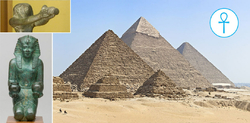- Retour accueil
- Vous êtes ici : Blog The Pyramids of the Cold The Pyramids of the Cold Section 4 • The Inclined Well Layout
The Pyramids of the Cold Section 4 • The Inclined Well Layout
Publié par Bruno Coursol dans The Pyramids of the Cold le 12/04/2022 à 20:14
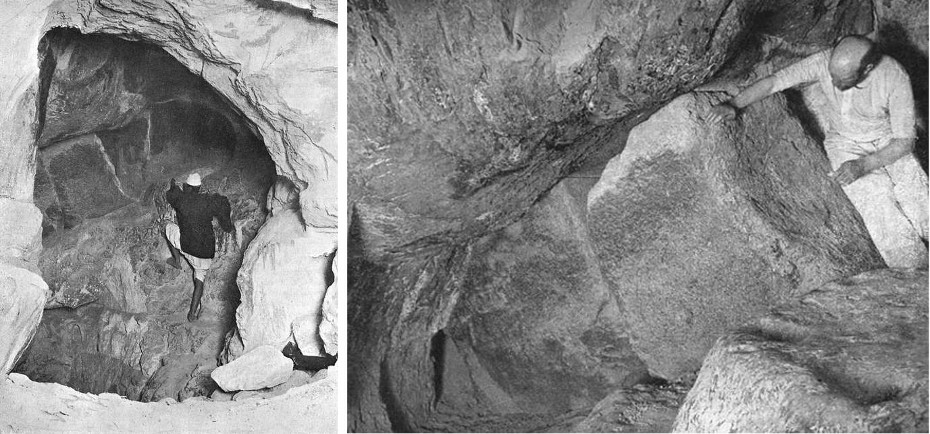
On the left is the cavity of the Caliph Al-Ma'mun, in which the water of the inclined well (the ascending passage of the Great Pyramid of Khufu) was drained into. The upper granite plug has been deified into goddess Taweret : "the Lady of the Well", the "Big One", the "Great One" and "the One Who Releases Water".
The Pyramids of the Cold - Section 4 • The Inclined Well layout
In summary : the structural particularities of the ascending passage, the 14 girdle stones and the interlocking polygonal arrangement of the blocks, are revealing the real function of this passage : it was designed to be flooded, exposed to repetitive shocks and to enormous pressure directed towards the exterior of the flooded well. The ascending passage was functioning as an inclined well.

The polygonal arrangement of the blocks of the ascending passage / inclined well of the Great Pyramid of Giza.
4.01 The polygonal arrangement of the blocks of the ascending passage
These blocks are displaying an interlocking layout revealing that the passage was also under a lot of longitudinal forces. If the girdle stones were set to counteract transversal forces passing through the ascending passage (from the inside to the outside of the well), the interlocking layout of the blocks reveals that the passage was also under strong longitudinal forces (from the top to the bottom of the well, and reverse).
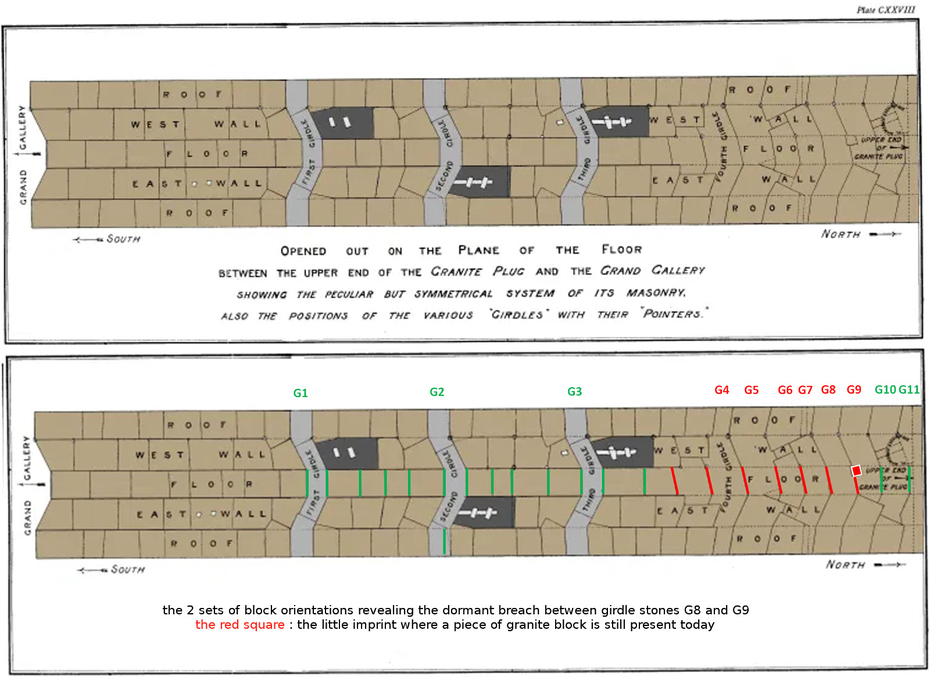
The layout of the girdle stones in the inclined well of the Great Pyramid of Giza (top view).
Original of the Diagram of the First Ascending Passage, by John and Morton Edgar, in "Great Pyramid Passages, Volume 1 (1910 edition)", plate CX, paragraph ref. 460, page 230 : https://archive.org/details/GreatPyramidPassagesVol11910Edition/page/n239/mode/2up
4.02 The girdle stones of the ascending passage indicate that it was an inclined flooded well
When you look attentively to the drawing of the Edgar brothers, showing the girdle imprints on the walls, floor and ceiling of the passage, you can see something absolutely amazing : these girdle stones were arranged in 2 sets of girdles, and that these 2 sets were positioned at a different angle to the vertical axis.
It is like the 2 sets of blocks are opening up to reveal a dormant breach. More amazing is that at the exact location where the breach is positioned, we can find a tiny squared imprint in the floor with a granite plug stuck inside !
Contrary to what seems to suggest all the ascending passage drawings mentioning the girdle stones, there is not just 3 or 4 of these huge blocks in the passage. Actually, the entire passage, from the G4 girdle (the lower of the usual girdles) to the lower part of the passage, is nothing else than 100% girdle stones. The fact is that when the Edgar brothers tried to understand the role of these girdle blocks, they couldn't make any sense of this lower part of the passage and all these girdles. They were only interested in finding distances between blocks in order to associate these distances to Bible or other historical events. Girdle stones from G5 to G14 are completely pressed against each other. They couldn't measure anything so they didn't talk about it (this is precisely what they wrote themselves), and they didn't draw them either. And since, everybody did the exact same thing.
In italic, are excerpts from "Great Pyramid Passages, Volume 1, by John and Morton Edgar 1910", sections 460 to 470.
Source : https://archive.org/details/GreatPyramidPassagesVol11910Edition/page/n239/mode/2up
Section 462, talking about the girdle stones : "Before leaving home we had recognized the importance of the three upper ones as marking important dates in the Law Dispensation".
Section 467 : "Those Girdles which lie lower down the passage than the three just described, are all in contact with one another".
Section 468 : "it would seem that the stones which form the Girdles here were originally built in solid, end to end, after which the bore of the passage was cut through them. Above the fourth Girdle, however, there can be no doubt that the passage was constructed in the usual way, i.e., that the floor was first laid, the walls erected at the proper distance apart on the floor, and the roof- stones then placed on top of the wall-stones".
The problem is that this part of the passage, from G4 to G14 is so more protected with these girdles, that it makes the usual ones look like insignificant.
If you want to understand the girdle stones layout, you need to understand that the passage was flooded and that the girdles were acting as an integrated strapping of the well.
The pressure inside the well was probably perfectly distributed on all its surface by a another complete wooden casing, that also allows the well to be waterproof. It is possible though, that the seal between the blocks was sufficient enough so that no casing was needed. Probably the center part of the floor casing part is thinner than the rest of it, and it makes a kind of gutter inside the casing allowing air and water to get out of the well, into the entry of the horizontal cooling passage.
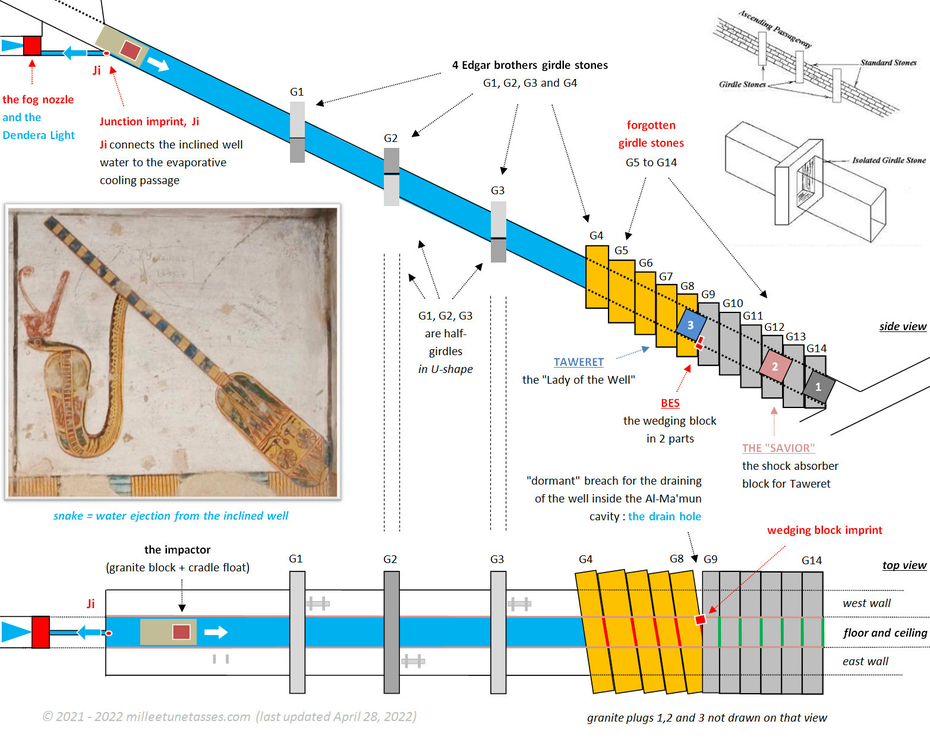
The layout of the girdle stones in the inclined well of the Great Pyramid of Giza. Photograph from tomb KV 11 of Ramesses III, side chamber, image # 21076 by Matjaz Kacicnik, courtesy of ARCE, American Research Center in Egypt in partnership with the American University in Cairo Egyptology Department : https://thebanmappingproject.com/images/21076jpg
During the entire operating period of the Great Pyramid, the bottom of the inclined well was sealed by the Taweret block : the upper granite plug. Taweret was maintained in position by a wedging block presenting an easy to break protruding part, getting out of the floor of the well. The breaking of that fragile part released the Taweret block and the waters of the well were drained through the dormant breach, between the Girdle Stones G8 and G9.
More on the Bes and Taweret blocks as well as the draining of the inclined well triggered from the grotto, in Section 6 to 9.
4.03 The lower end-to-end girdles are arranged in 2 sets with different orientations
When you look attentively to the drawing of the Edgar brothers (plate CXXVIII), showing the girdle imprints on the floor of the passage (red and green short lines), you can see something absolutely amazing : these girdle stones were arranged in 2 sets of girdles, and that these 2 sets were positioned at a different angle to the vertical axis.
This particular layout reveals a dormant breach, just waiting to be opened up, and it is located right where the Al Ma'mun cavity has been digged.
4.04 The breach opening for the shutdown procedure of the pyramid
The 2 sets of girdles with different orientations are opening up to reveal a dormant breach. More amazing is that at the exact location where the breach is positioned, we can find a tiny squared imprint in the floor with a granite plug still stuck inside, and on the other side of the wall is the huge Al-Ma'mun cavity, leading to the subterranean part of the Great Pyramid.
My guess is that this particular layout was designed to drain the well for the shutdown procedure of the pyramid : a small granite block would have been positioned in the small imprint (colored in blue on the drawing), placed against the wall, directly next to the dormant breach.
This is Petrie talking about the part just ahead (south) of the granite plugs : "The present top one is not the original end ; it is roughly broken, and there is a bit of granite still cemented to the floor some way farther South of it". Source : The Pyramids and Temples of Gizeh par W. M. Flinders Petrie. Chapter : Ascending Passage, page 21.
When time has come to shut the pyramid down, the impactor is lifted up to the top of the grand gallery one last time, unless this time there is no float anymore. When the impactor is released and enter the inclined well, it doesn't pop back up to the surface but sink to the bottom of the well with high velocity. When it hits the granite plug block n°3 that was dormant all along by this small granite block in the imprint, it opens the breach and all the water is drained trough the cavity of Al-Ma'mun.
The draining of the well was necessary in order to empty completely the pyramid of all its content. More about it farther below, same post (dormant breach, little imprint, draining of the well into the cavity of Al-Ma'mun...).
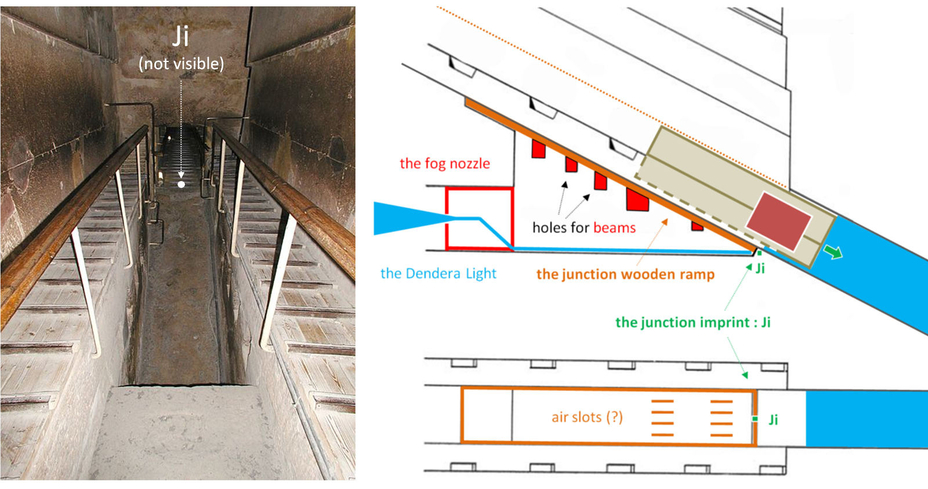
4.05 The Junction imprint between the inclined well and the horizontal cooling passage
the Junction imprint was connecting the inclined well waters with the horizontal evaporative cooling passage. Without it, there wouldn't be any pressurized water ejected from the inclined well towards the evaporative cooling passage.
This little imprint was absolutely essential once the wooden ramp would have been in place.
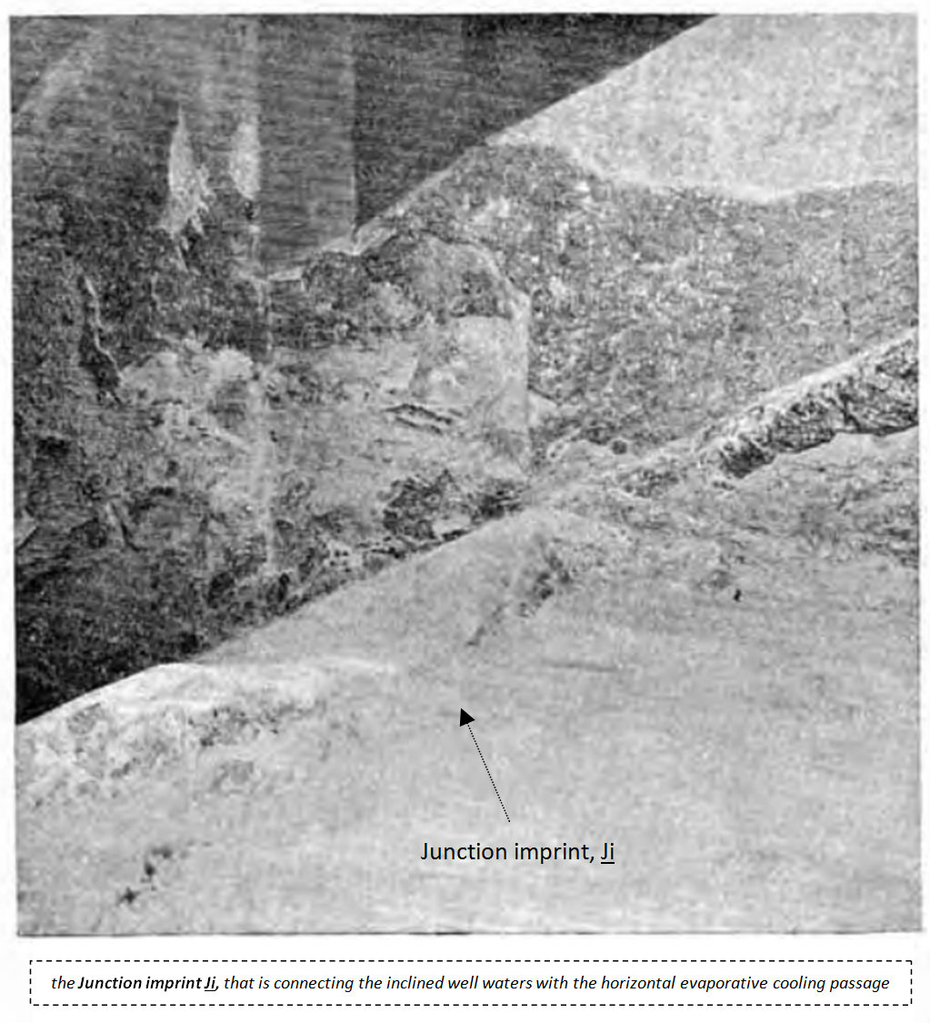
Image of the Junction imprint, taken by John and Morton Edgar and published in "Great Pyramid Passages Vol 1, 1910 edition", plate CXLIX, page 274 : https://archive.org/details/GreatPyramidPassagesVol11910Edition/page/n283/mode/2up
4.06 The only known photograph of the Junction imprint ?
The only image of the Junction imprint that I was lucky to find, has been taken by John and Morton Edgar and published in "Great Pyramid Passages Vol 1, 1910 edition", plate CXLIX, page 274.
Excerpt from "Great Pyramid Passages" : "Our photograph of this lower part of the East Ramp where it butts against the north wall of the Grand Gallery (Plate CXLIX), shows also the abrupt cut-off of the smooth sloping floor, a short distance up (south) from the line of the north wall of the Gallery."
It looks like the floor of the ascending passage has been pretty rapidly covered with wooden boards to facilitate the tourists' progression in the passage, and that the Junction imprint in now hidden underneath.
It is also possible that it had been filled up with cement, like it had been done in the cut-off of the top platform of the Grand Gallery.
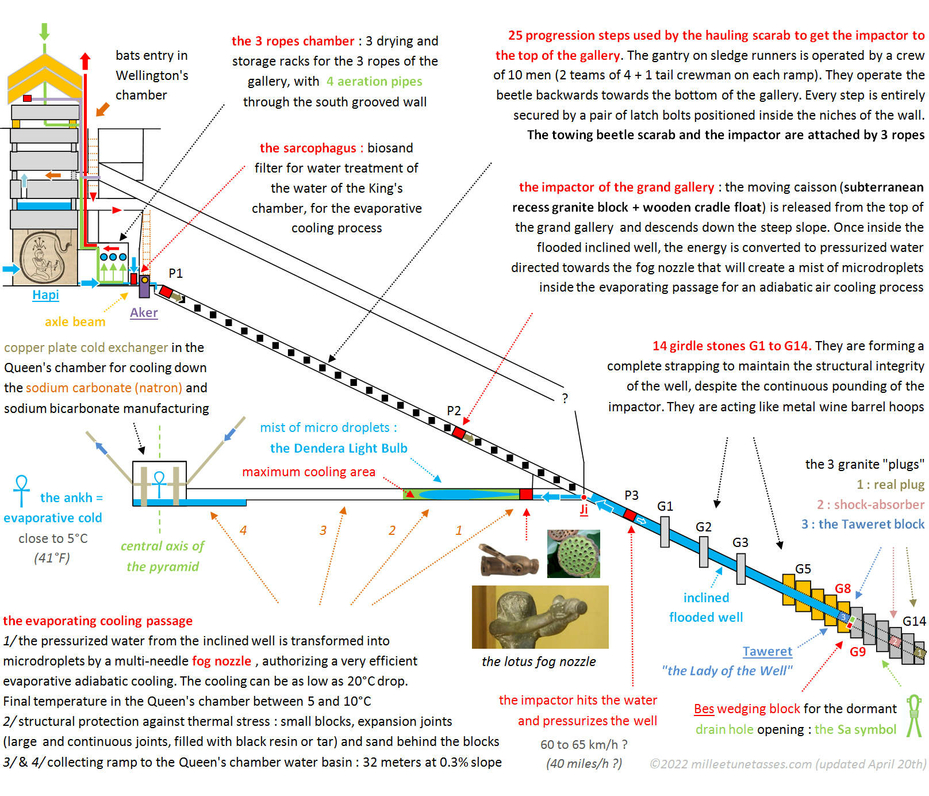
Diagram of the Great Pyramid of Egypt in operation, before the shutdown procedure and the draining of the inclined well.
4.07 Summary of the study : hidden behind the academic vision of the ancient Egyptian religion, a vast number of metaphors are describing some of the most advanced science and technological knowledge of that time : ancient Egyptian gods were nothing else than pharaohs' metaphoric self-glorifications of their theoretical and experimental scientific accomplishments in physics and chemistry.
Pharaohs used the power of Science to legitimate themselves as kings of Egypt : they forged an entire religion, based on science to rule their kingdom, and they presented that science as Magic.
The end game of this technological program that probably started on the very first Dynasty, was the Great Pyramid of Giza where evaporative cooling was engineered in the known part of the pyramid from the pressurized water produced in the inclined well, known today as the ascending passage.
The evaporative cold simply took advantage of the power of water, and was most probably necessary to cool down chemical manufacturing of sodium carbonate and sodium bicarbonate produced by an ammonia-soda Solvay process, as suggested by the very strong ammonia smell and the limestone kiln in the so-called burial chamber of the Red Pyramid. At that time, sodium carbonate was called natron, and it was the salt used for the mummification of the pharaohs (Sections 14, 15 and 16).
The cooling seems to have represented the most difficult part of the process, as suggested by the Step Pyramid's official name : according to scholars, the very first pyramid complex, the Step Pyramid of Djoser, was called "the refreshment of the Gods". No doubt that a more accurate translation would certainly be "the cooling of the Gods".
It means that ancient Egyptians were the first civilization to master a Solvay-like process for sodium carbonate manufacturing, long before it got reinvented in the 1800's in Europe. The key elements of that process is the temperature control of the chemical reactions (the cooling), and the dome shaped plate necessary for the counterflow chemical reactions to occur in an efficient way. That counterflow reaction plate is what really is the disc of Sabu.
As shown with Akhenaten and Nefertiti, the creation of the evaporative cold was the most sacred accomplishment of all (Section 17), and this is exactly what the Dendera Light is all about : the Dendera Light is the fog of microdroplets of liquid water that evaporates and creates the cold. Talking about the snake inside the Dendera Light Bulb : "The field surrounding Ra’s snake form is referred to in ancient Egyptian literature as protective magical energy in liquid form that all gods and pharaohs possess" (Faulkner, Section 2).
Everything that had been done in the Great Pyramid of Giza inspired most of the ancient Egyptian religion, and it had been glorified into what we know today as the Underworld.
The Underworld is referring to the chambers and passages of the Great Pyramid of Khufu, and in particular to the Grand Gallery where a hauling gantry beetle operated a wooden coffin shaped impactor that had a small nested granite block inside it. The impactor generated endlessly, over and over, maybe every 15 minutes the pressurized water that was then transformed into a fog of microdroplets inside the horizontal cooling passage.
The Grand Gallery of the Great Pyramid where the act of hauling was done, is the "Secret Hauling Cavern of the Underworld" described in the Amduat "Book of the Hidden Chamber".
The most important chamber of the Great Pyramid wasn't the King's chamber that only was the main water tank of the pyramid, but the Queen's chamber, the only one on the central axis of the pyramid. Because the Queen's chamber was inaccessible from the rest of the pyramid, it was glorified into the "Hidden Chamber of the Underworld" (Section 11), and because the Queen's chamber was the coolest place in the pyramid (about 5°C / 41°F), and with a constant 100% Humidity rate, this chamber was the one where the biggest amount of very hard salt encrustation had been documented by the first explorers of the pyramid in the 1800's and before it had been removed in 1998 by Zahi Hawass (Section 1). Very hard salt encrustation is the signature of the evaporative cooling process, even nowadays.
The most incredible thing is that pretty much everything I've just said, actually appears in one single myth, but it doesn't originate from ancient Egypt : it is the "Churning of the Ocean" Hindu myth that produces the immortal nectar Amrita. The fact is that the endless churning of water that ends up with the production of an elixir that gives eternal life, is exactly what were doing ancient Egyptians in the inclined well : natron was the salt used for the mummification of pharaohs.
Natron gave eternal life to pharaohs, just like the Amrita (Section 19).
Poster un commentaire

